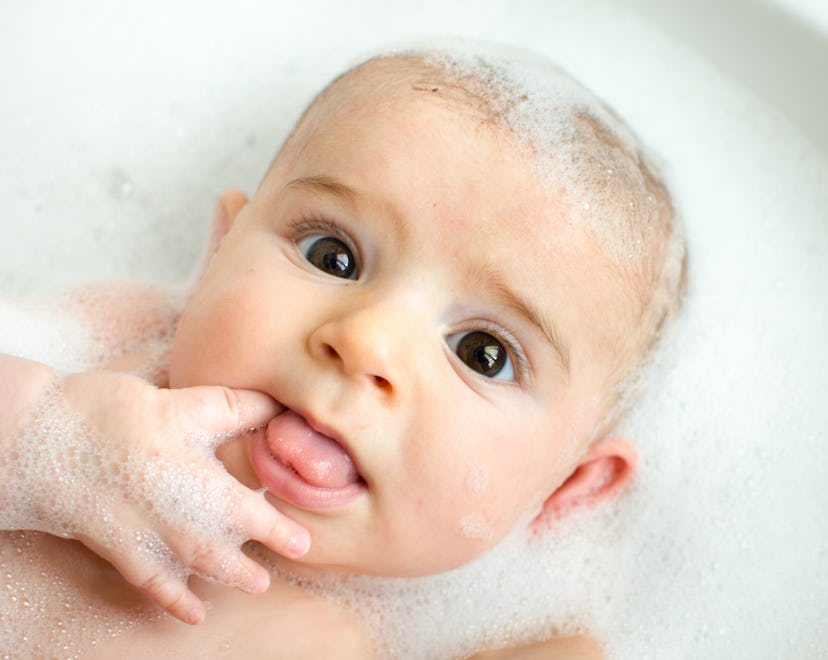Baby

Cradle Cap Is Normal & So Is Your Desire To Get Rid Of It. Here’s How
It’ll go away on its own, but you can speed up the process if you want to.
You’re running your fingers through your newborn baby’s hair — or cupping that sweet little bald head — and you notice that it’s, well, got something on it. Wait, what is that? Perhaps your first thought is “ew?” And if so, who could blame you? What you’re looking at just might be cradle cap, also known as seborrhea dermatitis. If you’re worried at all, or need confirmation that the slightly scale-like, flaky stuff on your baby’s head — or hiding not-so-subtly under their soft mop of baby hair — is indeed cradle cap, it’s always a good idea to bring it up with your pediatrician, or even send them a photo if you can. Once you’re sure what it is, you may be wondering exactly how to get rid of cradle cap. And while it doesn’t require treatment, it’s normal to wish it were gone. Thankfully, cradle cap treatment is an option and it’s easy to treat at home.
What is cradle cap?
Cradle cap is “vernacular for seborrhea dermatitis that occurs on the scalp of newborns,” explains Dr. Angelica Espinosa-Louissaint, a pediatrician at Boston Children’s Hospital and co-founder of Commonwealth Pediatrics. “It is not infectious or contagious,” she stresses, nor it is painful or itchy. Though it may look, well, unpleasant, both Espinosa-Louissaint and Dr. Natasha Burgert, a pediatrician, emphasize that cradle cap is not worriesome and is incredibly common. “The sticky, flaky areas are due to increased cell turnover, natural skin shedding that results in clumps of dead skin,” Burgert explains.
You might begin to notice cradle cap around the first 2-4 weeks of your baby’s life, but for many babies, cradle cap will be “resolved by 4-6 months old, generally improving each month,” says Espinosa-Louissaint. It is usually centered on their head and forehead — thus cradle “cap” — but you may notice it on their eyebrows, or Espinosa-Louissaint says it can even “extend onto their body.” In those early months, your baby probably has relatively frequent well-visits scheduled, and if you’re worried at all about the cradle cap, it’s always a good idea to ask your pediatrician for their insight.
How to get rid of cradle cap
Despite the fact that cradle cap isn’t something you need to be concerned about, and is something that your baby is blissfully unaware of, many parents are bothered by its presence on their baby’s head. And true, it can be unsightly, or seem to interfere with their otherwise-perfect little mop of baby hair. So, if you want to get rid of cradle cap rather than wait for it to resolve on its own, there are treatment options. “Generally, we advise that parents don’t need to do anything because it will self resolve,” says Espinosa-Louissaint. If you do want to do something to treat cradle cap, though, she recommends the following cradle cap treatment:
- Brush flakes from scalp gently with a fine tooth baby comb or soft baby brush moving from the hairline on forehead back toward the nape of the neck. Burgert mentions that FridaBaby’s DermFrida is “perfect for the task.”
- Apply small amount of dandruff shampoo, like Selsun Blue, which has selenium sulfide in it to the dry scalp without water and rub in gently.
- Leave this on like a masque treatment for 3-5 minutes.
- Rinse off thoroughly.
If you’re worried at all about using a product like Selsun Blue on your newborn, Dr. Tracy Funk, an Associate Professor of Dermatology and Pediatrics at the OHSU School of Medicine, has a slightly milder suggestion. “If parents want to treat, I usually start by having them apply a small amount of mineral oil or petroleum jelly to the scalp, massage it in to gently loosen the scale (they can also use a soft brush), then wash the scalp with a gentle baby shampoo,” explains Funk. “If that is not successful, I recommend seeing their pediatrician or a dermatologist for medicated treatments.”
Doing this once a week will usually keep the condition under control until baby outgrows it. My own children had extremely persistent cradle cap, even as toddlers and into the preschool years. They remained completely oblivious, and as their baby hair grew into bigger-kid hair, it wasn’t noticeable at all. Whether you treat it or not, cradle cap is nothing to worry about.
Experts:
Dr. Angelica Espinosa-Louissaint, a pediatrician at Boston Children’s Hospital and co-founder of Commonwealth Pediatrics
Dr. Natasha Burgert, a pediatrician and spokesperson for the American Academy of Pediatrics
Dr. Tracy Funk, M.D., Associate Professor of Dermatology and Pediatrics at the OHSU School of Medicine
This article was originally published on